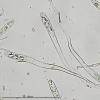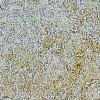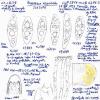
24-11-2025 15:23
Arnold Bû¥schlenHallo, auf einer offenen KiesflûÊche am Rande ein

23-11-2025 11:16
Bohan JiaHi,ô I found small discs growing on dead stem of

21-11-2025 10:56
 Christopher Engelhardt
Christopher Engelhardt
Very small (~0,5 mm) white ascos, found yesterday

21-11-2025 10:47
 FranûÏois Frelûˋchoux
FranûÏois Frelûˋchoux
Bonjour,Peut-ûˆtre Mollisia palustris ?Trouvûˋe su

21-11-2025 11:52
Jean-Luc RangerBonjour û tous, on voit toujours 2 espû´ces areni
Pezicula sp?
Miguel ûngel Ribes,
03-03-2011 01:15
 Buenas noches
Buenas nochesEsta pequeûÝa especie naranja de 1-2 mm crecûÙa sobre madera de planifolio en bosque de laurisilva, subgloboso-urceolado de joven y turbinado con el himenio convexo de adulto, de consistencia firme.
Ascas con croziers, biseriadas, con la base muy estrecha y larga, IKI ô¢creo que no azul?, de (149) 159.1 - 203.7 (218.1) x (9.9) 10.7 - 12.3 (14.3) ôçm; N = 20; Me = 186.5 x 11.5 ôçm, en agua, a 600x, a partir de material fresco.
Esporas en forma de pipa, muy pocas veces con 1-2 septos y varias gû¤tulas medianas, de (14.1) 14.9 - 18.2 (19) x (4.2) 4.7 - 6 (6.3) ôçm; Q = (2.5) 2.7 - 3.4 (4) ; N = 36; Me = 16.4 x 5.4 ôçm ; Qe = 3.1
ParûÀfisis muy particulares, muy ramificadas, multiseptadas, moniliformes e irregulares en toda su longitud.
Muchas gracias por vuestra ayuda,
________________________
Good night
This small orange species 1-2 mm was growing on planifolium wood in laurel forest, subglobose-urceolate when young and turbinate with convex hymenium in adults, flesh firm.
Asci with croziers, biseriate, with very narrow and long base, IKI ô¢I think not blue?, (149) 159.1 - 203.7 (218.1) x (9.9) 10.7 - 12.3 (14.3) microns, N = 20, Me = 186.5 x 11.5 microns, in water, 600x, from fresh material.
Pipe-shaped spores, rarely with 1-2 septa and several medium-size guttules, from (14.1) 14.9 - 18.2 (19) x (4.2) 4.7 - 6 (6.3) microns, Q = (2.5) 2.7 - 3.4 (4), N = 36, Me = 16.4 x 5.4 microns, Qe = 3.1
Paraphyses very curios, highly branched, multiseptate, moniliform and irregular along its length.
Thank you very much for your help
Miguel û. Ribes
Miguel ûngel Ribes,
03-03-2011 01:22
Hans-Otto Baral,
03-03-2011 09:37
Miguel ûngel Ribes,
03-03-2011 23:13

Re:Pezicula sp?
Dear Zotto
Here is an asci apex collage.
I have been reading the paper of Prof. Korf and your plate and I think the paraphysis in this collection are slightly different, much more moniliform. Is it not important?
In this album you could see all my micro photos, there are many "normal" paraphysis, but also many other moniliform-deformed, at least at the apex.
https://picasaweb.google.com/miguelangel.ribes/ZugazaeaAgyrioides28111066?authkey=Gv1sRgCO2X_NPbhorimQE&feat=directlink
Thank you very much,
Miguel û. Ribes
Here is an asci apex collage.
I have been reading the paper of Prof. Korf and your plate and I think the paraphysis in this collection are slightly different, much more moniliform. Is it not important?
In this album you could see all my micro photos, there are many "normal" paraphysis, but also many other moniliform-deformed, at least at the apex.
https://picasaweb.google.com/miguelangel.ribes/ZugazaeaAgyrioides28111066?authkey=Gv1sRgCO2X_NPbhorimQE&feat=directlink
Thank you very much,
Miguel û. Ribes
Hans-Otto Baral,
03-03-2011 23:24

Re:Pezicula sp?
Dear Miguel
many thanks for these nice photos. About branching of paraphyses I often saw high variation, f.ex..in Orbilia or Vibrissea etc.
I downloaded a lot of your photos, but i regret the micros are in low resolution (700 x 556). If you have higher I would like them at least in double.
Zotto
many thanks for these nice photos. About branching of paraphyses I often saw high variation, f.ex..in Orbilia or Vibrissea etc.
I downloaded a lot of your photos, but i regret the micros are in low resolution (700 x 556). If you have higher I would like them at least in double.
Zotto
Miguel ûngel Ribes,
04-03-2011 00:18

Re:Pezicula sp?
I am sending to your private the photos.
Thank you again,
Miguel û. Ribes
Thank you again,
Miguel û. Ribes










